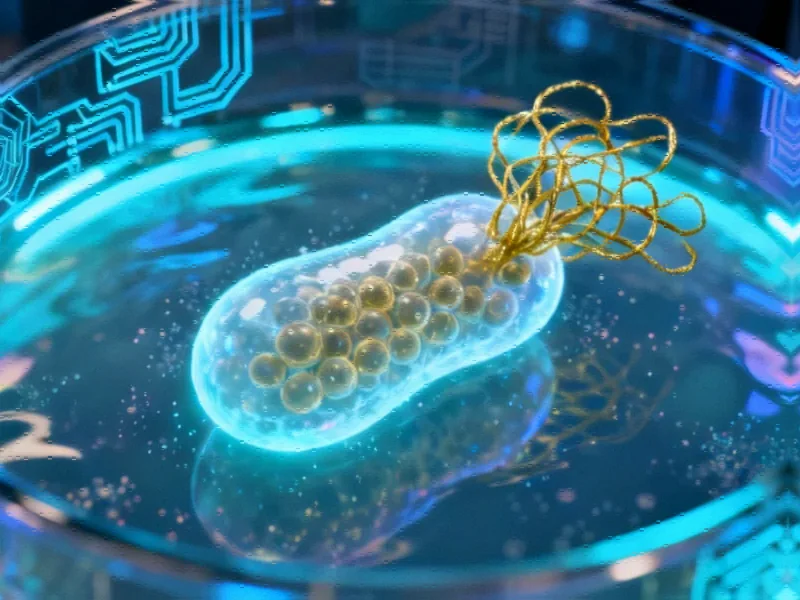Gene-Editing Platform Overcomes Cancer Treatment Resistance
Scientists have developed a novel nanoplatform that uses CRISPR gene editing to transform how cancers respond to immunotherapy, according to reports published in Nature Biomedical Engineering. The technology targets haem oxygenase-1 (HO-1), a key enzyme that tumors use to develop resistance to reactive oxygen species, which are crucial components of many cancer treatments.
Table of Contents
Heritable Technology Reprograms Tumor Vulnerability
The NanoCRISPR/HO-1 scaffold represents a significant advancement because it creates heritable changes in cancer cells, sources indicate. This means the modified susceptibility to treatment can be passed to daughter tumor cells, effectively converting heterogeneous malignancies into uniformly treatment-sensitive populations. The platform’s design includes arginine-grafted polyethyleneimine and CpG motifs that work synergistically to enhance the cancer-immune cycle., according to further reading
Analysts suggest this approach addresses a fundamental limitation in photodynamic therapy, where tumors often develop genetic tolerance that reduces treatment effectiveness. By eliminating HO-1-mediated protection, the nanoplatform enables robust immunogenic cell death that can generate effective autologous cancer vaccines.
Combination Therapy Shows Promise Against Metastasis
When combined with αPD-L1 checkpoint inhibitors, the NanoCRISPR platform demonstrated remarkable effectiveness in melanoma mouse models. The report states that this combination therapy not only suppressed existing tumors but created durable immunological memory that protected against tumor rechallenge. This suggests potential applications in preventing metastasis and recurrence, two major challenges in cancer treatment.
Researchers noted the platform operated without causing adverse effects on primary immune cells, maintaining the immune system’s capacity to mount sustained anti-tumor responses. The technology‘s ability to work with the body’s natural immune mechanisms while overcoming evolved resistance represents what analysts suggest could be a paradigm shift in cancer vaccine development.
Future Implications for Cancer Treatment
This research provides new insights into creating effective cancer vaccine regimens that can adapt to tumor evolution. The heritable nature of the genetic modifications means that even as tumors grow and change, they maintain susceptibility to treatment. According to reports, this approach could potentially be applied to various cancer types where HO-1-mediated resistance presents treatment challenges.
The study demonstrates how nanotechnology and gene editing can be combined to create sophisticated therapeutic platforms that address multiple aspects of cancer biology simultaneously. As sources indicate, this multi-pronged approach—targeting genetic tolerance while enhancing immune activation—may represent the future of combination cancer therapies.
Related Articles You May Find Interesting
- Google Shifts Entire Infrastructure to Arm Architecture with AI-Assisted Migrati
- Intel’s Panther Lake Architecture Poised to Transform Windows 11 Into AI-First O
- Carbon Dioxide Enhancement Boosts Microbial Soil Strengthening for Offshore Dril
- Intel’s Panther Lake Chipset Paves Way for Agentic AI Transformation in Windows
- UK Data Watchdog Faces Scrutiny Over Afghan Security Breach Non-Investigation
References & Further Reading
This article draws from multiple authoritative sources. For more information, please consult:
- http://en.wikipedia.org/wiki/Autotransplantation
- http://en.wikipedia.org/wiki/Neoplasm
- http://en.wikipedia.org/wiki/Genetics
- http://en.wikipedia.org/wiki/Cell_death
- http://en.wikipedia.org/wiki/Immunogenicity
This article aggregates information from publicly available sources. All trademarks and copyrights belong to their respective owners.
Note: Featured image is for illustrative purposes only and does not represent any specific product, service, or entity mentioned in this article.



